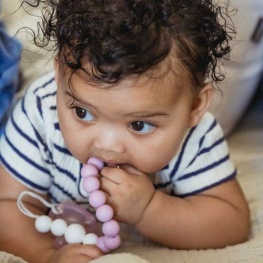Lead Poisoning

On this page:
- What is Lead Poisoning?
- How Lead Poisoning Happens
- Protect Your Child From Lead
- If Your Child is Lead Poisoned
What is Lead Poisoning?
- Lead poisoning happens when you swallow or breathe in lead, or drink water from lead pipes.
- Children under 6 years old are most at risk.
- Most children get lead poisoning from paint dust in homes built before 1978.
- Lead poisoning can cause learning disabilities and behavior problems.
- A lead test is the only way to know if a child has lead poisoning.
How Lead Affects the Body
Even if there are no clear signs of lead poisoning, lead still affects the body. Even low levels of lead in the blood of children can result in:
- Behavior problems and hyperactivity
- Lower IQ and learning problems
- Slowed growth
- Hearing problems
- Anemia
Signs of lead poisoning
Often there are no signs. Your child can have lead poisoning and not look or act sick. The only way to know is to have a blood test done.
How Lead Poisoning Happens
The most common cause of lead poisoning is when children play near areas with worn out or damaged paint. They can get invisible lead dust on their hands and toys. Then, when they put their hands or toys in their mouth, they can get lead poisoning.
Lead in Your Home
Lead is often found in:
- Paint and varnish in homes built before 1978, especially if it is peeling or chipping
- Drinking water when lead pipes or solder are present
- Dirt, hobby areas and workplaces, varnishes on antiques, old painted toys and pottery
- Leafy vegetables grown in contaminated soil or eggs from chickens that ate lead contaminated materials.
- Spices imported from Mexico, India, Asia, and the Middle East. Common imported spices with possible lead contamination include: Cumin, Turmeric, Chilies, Curry Powder, Kabsa, Ginger, Allspice, Garam Masala and Chloe Masala
- Certain imported candies, such as candy from Mexico that contains chili or tamarind
- Ceramic dishes, and folk remedies may also be contaminated with lead
Lead in Your Community
Children may also be exposed to lead in childcare facilities, schools, and homes of friends or family. Talk to your childcare provider or school staff to find out what is known about lead in these places.
You can read recommendations we have made to schools and childcare centers about minimizing lead in drinking water.
Almost all emissions of lead into the air have been eliminated in Dane County. One remaining source of lead air pollution is gas used in some small planes. If you live within 0.62 miles of an airport that hosts small propeller planes, talk to your healthcare provider about lead testing. Learn more about the risk of lead poisoning.
Learn more about childhood lead testing in Dane County.
Protect Your Child From Lead
Take Precautions
Children under 6 years of age who live in or visit pre-1978 housing are at greatest risk for lead poisoning. These basic steps can help prevent a child from becoming lead poisoned or being exposed to lead:
- Wash floors and windows the right way.
- Wash your child's hands often, especially before eating and sleeping.
- Cover chipped or peeling paint with contact paper, duct tape, or a new layer of paint. Do not try to sand off lead-based paint.
- Eat healthful foods high in iron, calcium, and vitamin C; avoid fatty foods.
- Use cold tap water for drinking, cooking, and making infant formula.
Get Items Tested for Lead
- Our Laboratory tests for lead in paint, varnish and water.
- Wisconsin State Laboratory of Hygiene tests food suspected of lead contamination. Call (800) 442-4618 or (608) 224-6202.
- Wisconsin Occupational Health Lab tests for lead dust. Call (608) 224-6210.
Get Your Child Tested for Lead
Talk with your child’s health care provider about lead poisoning testing. Read more about testing recommendations.
If you do not have health insurance call us at (608) 243-0304 and ask to speak with the Lead Program Nurse.
If you buy a home or rent an apartment:
- If you buy or rent a home or apartment built before 1978, you must be told if there are lead hazards in the home.
- It is against the law for you to be evicted or harassed if you complain about lead.
- Call us at (608) 242-6515 if you have not received information about possible lead hazards in your home or rental.
- Learn how to do lead safe painting projects.
If Your Child is Lead Poisoned
If a child has a blood lead level of 5 µg/dL or higher, they have lead poisoning. We help families whose children have lead poisoning by:
- Assessing their home and other places the child visits for lead.
- Giving information about managing lead hazards in their home.
- Providing ongoing case management to make sure the lead level is going down. That may include assessing the child’s development and making sure they get medical care.
We Work to Prevent Exposure to Lead
- We monitor for the prevalence of lead in the community and provide recommendations to prevent lead poisoning.
- We enforce the City of Madison lead ordinance, Madison General Ordinance 7.49, to make sure that property owners and contractors follow safe work practices when painting or remodeling older housing.
Resources
- Healthy Homes and Lead Hazard Control, US Housing and Urban Development
- Learn about Lead, US Environmental Protection Agency
- Lead-Safe Wisconsin, WI Department of Health Services
- Lead, Centers for Disease Control and Prevention
- Protect Your Family From Lead, Environmental Protection Agency (English / Español)
- Certified Companies Offering Lead Abatement Services, Wisconsin Department of Health Services
- How to Clean Windows Properly, City of Milwaukee (English / Español)


